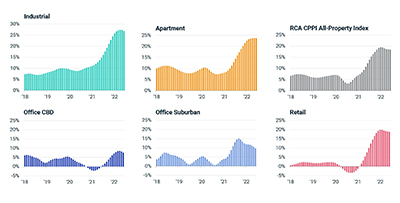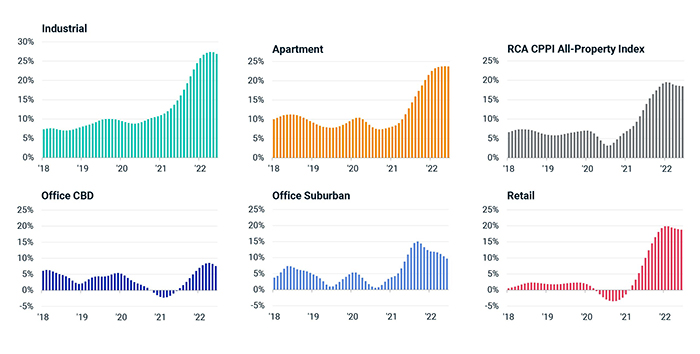
Commercial Real Estate Prices Climb Nearly 19% Y0Y

U.S. commercial real estate property prices grew at a double-digit rate in June amid sustained demand, reported Real Capital Analytics, New York.
The RCA CPPI National All-Property Index climbed 18.5% in June from the prior year, just below the record-high 19.5% pace seen in January, said Michael Savino, Senior Analyst with Real Capital Analytics.
“Price increases in the industrial and apartment sectors were the largest among the property types,” Savino said, noting a 26.9% annual gain in the industrial sector and a 23.7% increase for apartments from a year ago.

Savino said the retail sector’s annual pace held steady in June at 18.8%, down slightly from the record high achieved early in 2022.
Office price growth slowed, RCA reported. Suburban offices slowed to a 9.7% growth rate and central business district price eased to a 7.6% rate.
The CoStar Group, Washington, D.C., said its commercial property price indexes reversed first-quarter losses in the second quarter. The research firm’s value-weighted index, which is more heavily influenced by high-value trades, moved 3.7% higher to 302 during the second quarter, compared to a 1.6% loss in the first quarter. CoStar’s equal-weighted index, which tracks the more numerous but lower-priced property sales seen in secondary and tertiary markets rose by 8.7% to 320 in the second quarter, more than reversing its 0.3% first-quarter loss.
CoStar reported CRE transaction volume rose by 4.9% during the quarter to $49.0 billion after a first-quarter slump. “That slump followed an extraordinary surge of activity in fourth-quarter 2021,” CoStar said in its quarterly Commercial Repeat-Sale Index report. Investment-grade volume exceeded $30 billion in the second quarter, 2.7% higher than in early 2022, while commercial-grade volume increases 8.8% to $18.4 billion. The share of sales considered distressed remains low, CoStar reported.
Only 22 of the 1,321 repeat-sales trades examined in June were distressed sales. General commercial distressed sales accounted for 13 of the distressed trades, below its pandemic average, and CoStar found nine investment-grade distressed sales in June, accounting for 0.7% of all repeat-sales trades.
